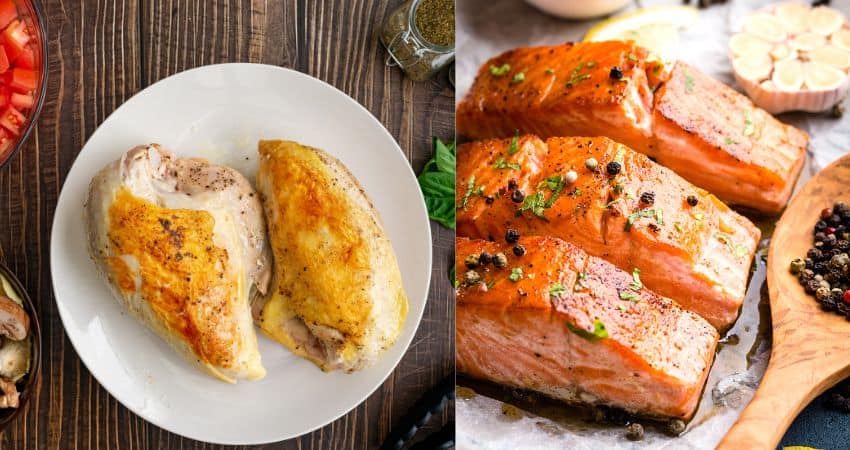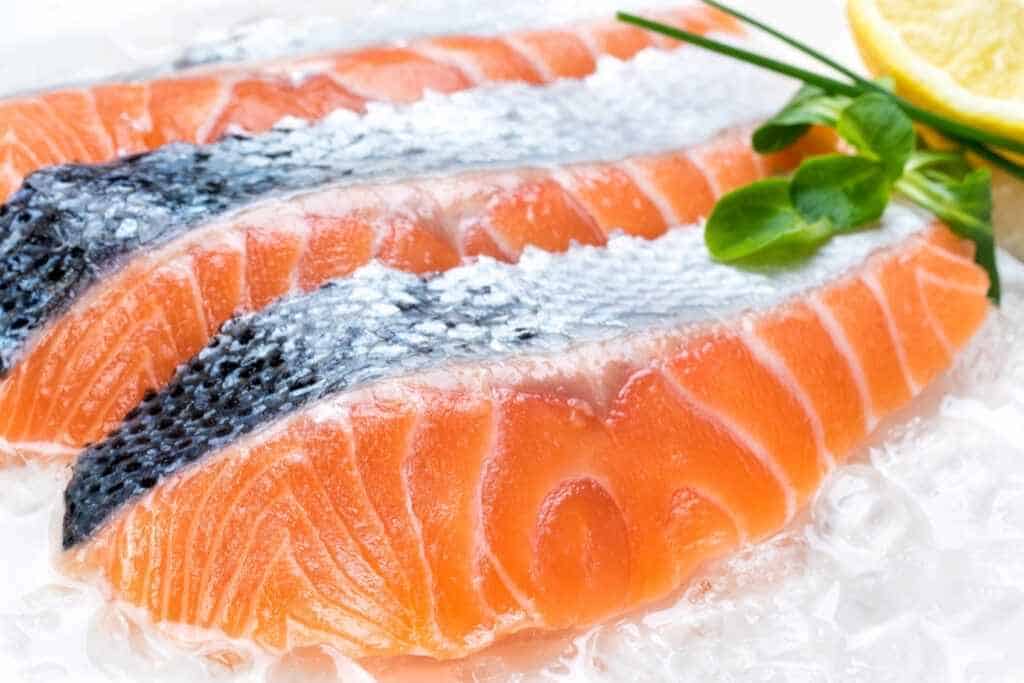Salmon vs Chicken: Which is Healthier?
Salmon and chicken are two popular types of meat, but many people don’t know which one is healthier to eat.
Salmon is healthier to eat than chicken because it contains more heart healthy omega-3 fatty acids, B vitamins and minerals than chicken. Chicken also contains more calories per serving than salmon does.
The article will break down each nutrient and compare them side-by-side. The comparison includes the different parts of the chicken like the wings, thighs, drumsticks and breasts. I’ll examine why salmon is healthier and the mercury levels in salmon and chicken.
Nutrient Comparison of Salmon and Chicken

As a Certified Health Coach many clients ask me about food comparisons including salmon and chicken. I purchase and consume salmon and chicken every week. Therefore, I have researched this topic in the past and present. Let’s examine them closely.
The following table compares the nutrients between raw salmon and raw chicken breast1, both skinless.
| Nutrient |
Salmon, raw Skinless (4 Ounces) |
Chicken Breast, raw Skinless (4 Ounces) |
| Calories | 161 | 136 |
| Fat | 7.2 g | 3 g |
| Protein | 23 g | 26 g |
| Omega-3 | 1.95 g | 0.02 g |
| B-6 | 0.9 mg | 0.9 mg |
| B-12 | 3.6 mcg | 0.2 mcg |
| Thiamin | 0.20 mg | 0.10 mg |
| Riboflavin | 0.40 mg | 0.20 mg |
| B5 | 1.8 mg | 1.6 mg |
| Iron | 0.9 mg | 0.4 mg |
| Niacin | 8.9 mg | 10.8 mg |
| Folate | 28.3 mcg | 10.21 mcg |
| Potassium | 555 mg | 378 mg |
| Magnesium | 32 mg | 31 mg |
| Phosphorus | 226 mg | 241 mg |
| Calcium | 13.6 mg | 5.6 mg |
| Zinc | 0.7 mg | 0.7 mg |
| Selenium | 41.4 mcg | 25.9 mcg |
When examining the table above, remember the chicken listed is white meat and not the dark part of the chicken or with the skin. A skinless chicken breast is considered the healthiest part of the chicken.
Salmon is better than skinless chicken breast due to its higher percentage of omega-3 fatty acids, vitamins and minerals. Salmon contains more omega-3s, B12, thiamin, riboflavin, iron, Folate, potassium, calcium, and selenium.
This is not saying skinless chicken breast is unhealthy. It’s very healthy and contains a wide variety of vitamins and minerals plus protein. Chicken breast contains a little more protein, niacin and phosphorus.
It contains a similar number of B5, magnesium and zinc. In addition, skinless chicken breast contains less fat than salmon, although the fat in salmon is considered healthy and from the omega-3 fatty acids.
It’s the omega-3 fatty acids which really separate the two and makes salmon the healthier choice. The omega-3 fatty acids can help fight inflammation, lower cholesterol and is beneficial for the joints and vision.
Omega-3 fatty acids are heart healthy and help keep the blood vessels healthy and cholesterol levels low. DHA and EPA fatty acids are associated with lowering blood pressure and improving the health of blood vessels ((National Center for Biotechnology: Marine Omega-3 Supplementation and Cardiovascular Disease)).
Both salmon and chicken breast contain good amounts of potassium but the salmon has almost 50% more. Potassium is beneficial for combating high sodium intake because it helps the body reduce fluids and rids excess sodium ((American Heart Association: How Potassium Can Help Control High Blood Pressure)).
In addition, potassium helps the blood vessel walls to relax. This is important because a stiffer blood vessel makes the heart pump harder and increases blood pressure.
A large number of scientific research have shown an association between low potassium levels and higher blood pressure ((Harvard Health: Potassium lowers blood pressure)).
There are different types of chicken, like the dark meat, which have different nutritional value than the white meat of the chicken breast. Let’s examine this in the next section below.
While chicken may be slightly less healthy, what about cod vs salmon? Check out the battle of these heavyweights in my article here, Cod vs Salmon: Is One Better?
Chicken Parts and Their Nutritional Values
Chicken is one of the most popular types of meat and it is healthy to eat when skinless and cooked healthy. Many people enjoy eating chicken because it is high in protein and contains few calories compared to other meat options2.
However, there are four different cuts of the chicken, and their nutrition information is all different.
Before adding seasonings like butter or other ingredients to your chicken dish, inspect the nutrition facts of an unseasoned, skinless and cooked cut of chicken. Adding butter, certain seasonings and other foods will add calories, carbs or other things you may be trying to avoid.

The table below list the nutrients of the other parts of the chicken and how they compare to salmon.
| Nutrient | Chicken thigh Skinless, raw 4 ounces |
Chicken drumstick Skinless, raw 4 ounces |
Chicken wings, Skinless, raw 4 ounces |
Salmon Skinless, raw 4 ounces |
| Calories | 137 | 131 | 143 | 161 |
| Fat | 4.7 g | 4.2 g | 4 g | 7.2 g |
| Protein | 22 g | 22 g | 25 g | 23 g |
| Omega-3 | 0.05 g | 0.05 g | 0.10 g | 1.95 g |
| B-6 | 0.5 mg | 0.4 mg | 0.6 mg | 0.9 mg |
| B-12 | 0.6 mcg | 0.5 mcg | 0.4 mg | 3.6 mcg |
| Thiamin | 0.09 mg | 0.10 mg | 0.06 mg | 0.20 mg |
| Riboflavin | 0.22 mg | 0.24 mg | 0.11 mg | 0.40 mg |
| B5 | 1.2 mg | 1.2 mg | 0.94 mg | 1.8 mg |
| Iron | 0.9 mg | 0.8 mg | 1.0 mg | 0.9 mg |
| Niacin | 6.2 mg | 5.8 mg | 8.3 mg | 8.9 mg |
| Folate | 4.5 mcg | 4.5 mcg | 4.5 mcg | 28.3 mcg |
| Potassium | 273 mg | 254 mg | 220 mg | 555 mg |
| Magnesium | 25 mg | 22 mg | 24 mg | 32 mg |
| Phosphorus | 209 mg | 196 mg | 175 mg | 226 mg |
| Calcium | 7.9 mg | 10.1 mg | 14.7 mg | 13.6 mg |
| Zinc | 1.7 mg | 2.3 mg | 1.8 mg | 0.7 mg |
| Selenium | 25.9 mg | 24.6 mg | 20.2 mcg | 41.4 mcg |
Examining the nutrients of the other parts of the chicken, you’ll see they are not as nutritious as the chicken breast. Even more so, salmon is healthier than the chicken thigh, drumstick and wing.
When comparing salmon to the whole chicken, even skinless, strengthens the argument salmon is healthier and better than the whole chicken.
Just like the chicken breast, the other parts do contain a wide variety of beneficial vitamins and minerals. Adding the skin would increase the number of fat, particularly the unhealthy saturated fats.
Chicken Breasts
A cooked skinless chicken breast that weighs 3.5 ounces contains:
- 165 calories
- 31 grams of protein
- 3.6 grams of fat
However, typically chicken breasts weigh more than 3.5 ounces. A typical skinless, cooked chicken breast weighs about 6.07 ounces (172 grams) or more, so the nutritional levels will scale up with it. A chicken breast that weighs about 6.07 ounces contains:
- 284 calories
- 53.4 grams of protein
- 6.2 grams of fat
Unseasoned and skinless chicken breasts don’t contain any carbs, so you won’t have to worry about them when you are eating plain, skinless chicken breasts. However, many seasonings contain carbs and calories.
If you are watching your calorie and carb intake, check the nutritional facts on the seasoning container.
Chicken Thighs
Boneless, skinless chicken thighs have more calories than chicken breasts. A cooked 1.8 ounce (52 grams) chicken thigh contains:
- 109 calories
- 13.5 grams of protein
- 5.7 grams of fat
Chicken thighs are 47% fat, but they are 53% protein. Chicken thighs are an excellent source of protein. However, because they contain much fat, you may prefer to eat other cuts of chicken.
Chicken Drumsticks
Skinless, cooked chicken drumsticks that weigh about 3.5 ounces (100 grams) contains:
- 172 calories
- 28.3 grams of protein
- 5.7 grams of fat
Chicken drumsticks are about 70% protein and only about 30% fat. If you don’t want to eat a lot of fat, chicken drumsticks are a great choice.
Chicken Wings
Chicken wings are the smallest part of the chicken, and many people enjoy eating them. However, they have quite a few calories. If you eat 3.5 ounces (100 grams) of chicken wings, you will eat the following:
- 203 calories
- 30.5 grams of protein
- 8.1 grams of fat
Chicken wings are 64% protein and about 36% fat. However, bone comprises most of the chicken wing, which is not edible.
Salmon
Salmon is better than chicken because it contains many amino acids and omega-3 fatty acids that, when consumed consistently, can improve people’s health.
The specific number of calories, grams of fat and grams of protein vary depending on the species of salmon. Keep that in mind as you continue reading.
If you want to know how many calories are in the food you are eating, look at the nutritional facts on the container, or ask the server if you are at a restaurant.
Nutrition Facts for Salmon
A skinless, cooked piece of Atlantic salmon that weighs 3 ounces contains 175 calories, 10.5 grams of fat, and 18.79 grams of protein.
A 100-gram piece of salmon has 3.45 – 10.43 grams of fat, 558 – 3,100 milligrams of fatty acids, and 45 – 74 milligrams of cholesterol. The specific amount of fat, fatty acids and cholesterol salmon have varies depending on the species of salmon ((USDA: Fish, salmon, chum, cooked, dry heat)).
Check out the following table to see the nutritional information for each salmon species. The following numbers are calculated for a 100 gram serving of raw salmon.
| Species of Salmon | Total Fats | Fatty Acids | Cholesterol |
| Atlantic | 6.34 g | 981 mg | 55 mg |
| Chinook (King) | 10.43 g | 3,100 mg | 50 mg |
| Coho | 5.93 g | 1,260 mg | 45 mg |
| Sockeye | 8.56 g | 1,495 mg | 62 mg |
| Chum | 3.77 g | 840 mg | 74 mg |
| Pink | 3.45 g | 558 mg | 52 mg |
Why is Salmon Healthy to Eat?
As mentioned earlier, salmon contains more omega-3s, B12, thiamin, riboflavin, iron, Folate, potassium, calcium, and selenium than chicken.
Salmon, like chicken, doesn’t have carbs unless you add seasonings and other food items to it. Although salmon does contain cholesterol, it doesn’t have enough to negatively impact a human’s cholesterol levels as other high-cholesterol foods do.
Salmon also has plenty of Omega-3 fatty acids, which help prevent cardiovascular disease. Salmon has quite a bit of protein but doesn’t contain much fat, which also helps the cardiovascular system.
Selenium is necessary to have a healthy thyroid, and salmon has quite a bit of selenium in it. Many thyroid disorders cause people to gain weight or make it hard to lose weight. Rapidly gaining or losing weight can stress the cardiovascular system.
A thyroid disorder can also cause other health defects. There are many reasons to keep your thyroid in good shape. If you eat foods with a lot of selenium, it may help your thyroid function well or at least start performing better than it has in the past.
Some other nutrients found in salmon and other fish may help lower the risk of disorders like depression, psychoses, dementia and ADHD. Overall, eating salmon can improve your health in many ways7.
Some people choose to cut meat from their diet when attempting to lose weight. However, eating more salmon than chicken is also an acceptable option.
Although chicken is cheaper, you can still find great deals on salmon in many places. To save some money on fresh seafood, would you believe some can be purchased on Amazon? Check out their current prices and selection here, Fresh Seafood.
Salmon will also help you lose weight faster than chicken, although neither chicken nor salmon contains carbs when eaten skinless and unseasoned.

Salmon and Chicken Mercury Levels
When discussing heath and the consumption of food, it’s difficult to ignore the mercury levels found in some fish. The Food and Drug Administration has issued warnings about consuming fish regarding their mercury levels ((FDA: Advice about Eating Fish)).
Salmon is not considered to have high levels of mercury compared to other seafood. The FDA lists salmon in the best choices for seafood regarding mercury levels. They recommend consuming salmon safely up to 2-3 times per week.
Chicken is not known to contain mercury8. Although a past report in 2006 found that some insects contain mercury and the animals that eat them, like chickens. The FDA hasn’t issued any known warnings about mercury in chicken.
If you have any questions to ask me about this article don’t hesitate to comment below or email us. You can find an email on our contact page.
Read Next – More Salmon vs Fish Articles!
Pink vs Red Salmon: What’s The Difference?
Tuna vs Salmon: Which Is Better?
Halibut vs Salmon: Which Is Better?
Char vs. Salmon – A Complete Comparison
Shrimp vs. Salmon: A Complete Comparison
- Nutrition Value: Chicken, raw, meat only, boneless, skinless, breast, broiler or fryers [↩]
- National Center for Biotechnology Information: Role of poultry meat in a balanced diet aimed at maintaining health and wellbeing: an Italian consensus document [↩]
- Nutrition Value: Chicken, raw, meat only, wing, broilers or fryers [↩]
- Nutrition Value: Chicken, raw, meat only, drumstick, dark meat, broilers or fryers [↩]
- Nutrition Value: Chicken, raw, meat only, thigh, dark meat, broilers or fryers [↩]
- Seafood Health Facts: Health Facts [↩]
- National Center for Biotechnology Information: Benefits of salmon eating on traditional and novel vascular risk factors in young, non-obese healthy subjects [↩]
- NRDC: Mercury Guide [↩]
